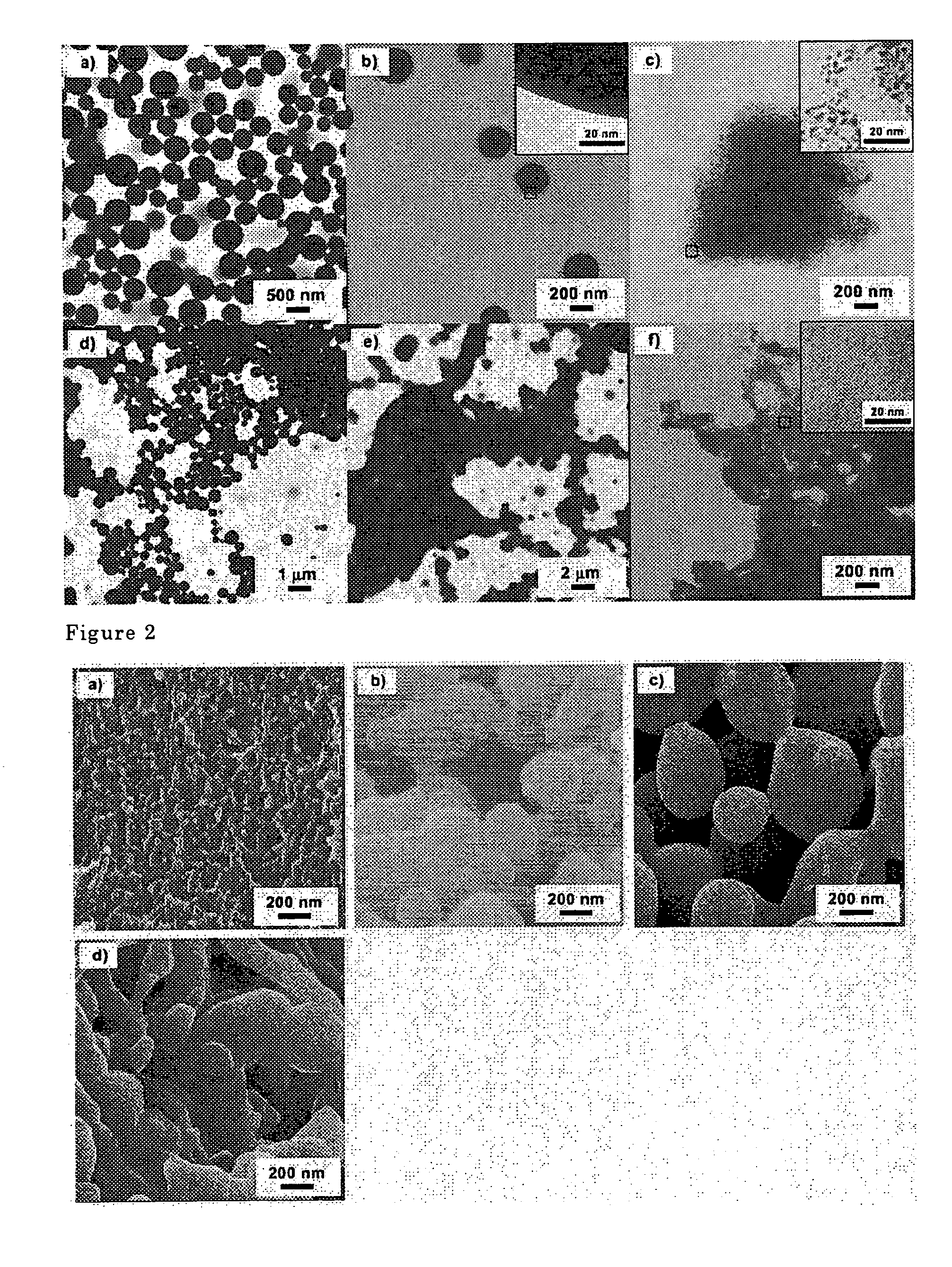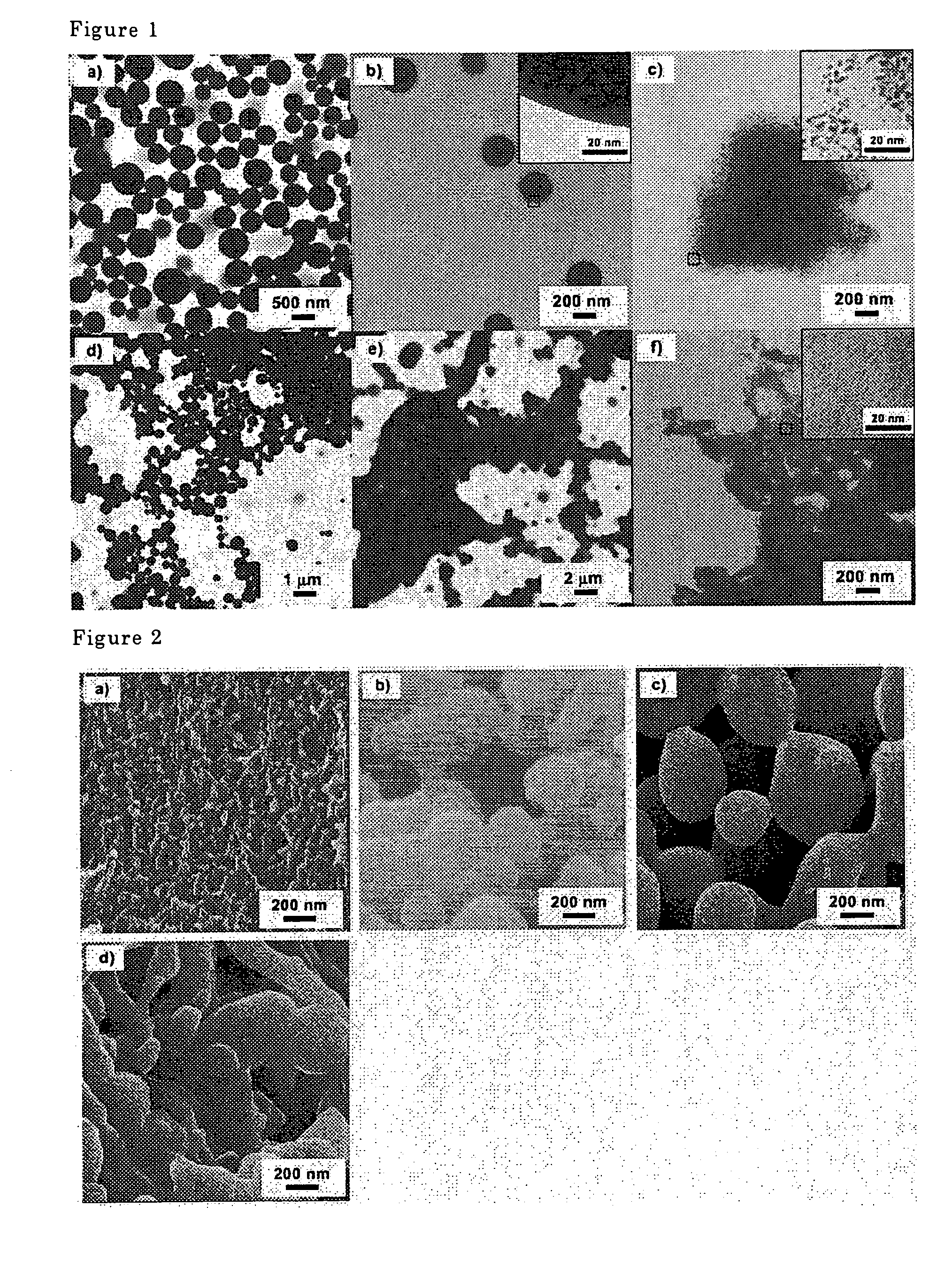Polymer-Supported Metal Cluster Composition
a technology of metal clusters and polymers, applied in the field of polymer-supported metal cluster compositions, can solve the problems of increasing the cost of catalysts, so as to achieve easy recovery and reuse, and high catalytic activity
- Summary
- Abstract
- Description
- Claims
- Application Information
AI Technical Summary
Benefits of technology
Problems solved by technology
Method used
Image
Examples
production example 1
[0056]A mixture of 2-phenylpropene (22.4 g, 190 mmoles), N-bromosuccinimide (23.7 g, 133 mmoles) and bromobenzene (76 ml) was superheated on an oil bath at 160° C. until the N-bromosuccinimide was dissolved. The reaction mixture was cooled to room temperature, and the precipitate was subsequently removed by filtration and washed with chloroform. The filtrate was purified by distillation under reduced pressure to obtain 12.1 g of 3-bromo-2-phenylpropene (b.p. 80° C. to 85° C. / 3 mmHg). 1H-NMR (CDCl3)δ=4.39 (s, 2H), 5.49 (s, 1H), 5.56 (s, 1H), 7.33-7.51 (m, 5H); 13C NMR (CDCl3)δ=34.2, 117.2, 126.1, 128.3, 128.5, 137.6, 144.2.
[0057]Five milliliters of a DMF solution of glycidol (7.4 g, 100 mmoles) was added to a suspension of 60% sodium hydride (1.6 g, 40 mmoles) (75 ml) at 0° C. Next, a DMF (10 ml) solution of the 3-bromo-2-phenylpropene (3.94 g, 20 mmoles) obtained as described above was added at the same temperature, and the mixture was subsequently agitated for 24 hours at room temp...
example 1
Synthesis of a Polymer-Supported Pd Cluster Composition
[0060]Polymer (1) (2.0 g) and Pd(PPh3)4 (2.0 g) were dissolved in 40 ml of dichloromethane (DCM) and were agitated for twelve hours. Forty milliliters of methanol was gradually added to this solution to form micelles, and 80 ml of methanol was subsequently added to agglomerate the micelles. The supernatant solution was removed by decantation, and the solids were washed several times with methanol before drying them under reduced pressure. The solids were subsequently heated for two hours at 120° C. to cross-link the micelles. The micelles were washed with THF and subsequently dried to obtain 1.9 g of a polymer-supported Pd cluster composition. The Pd concentration was 0.40 mmoles / g.
[0061]When the micelles were allowed to agglomerate at a high concentration, the micelles underwent a morphology change from spherical micelles (FIG. 1d) through lamellar micelles (FIG. 1e) to rod shaped micelles. Further, by cross-linking the micelle...
example 2
Synthesis of a Polymer-Supported Pd Cluster Composition
[0062]Polymer (1) (500 mg) and Pd(PPh3)4 (500 mg, 0.43 mmoles) were dissolved in 10 ml of dichloromethane and added gradually to 50 ml of t-amyl alcohol (t-AmOH) to form micelles (FIG. 1a). The reaction system was subsequently agitated for eight hours. The reaction vessel was sealed, and the micelles were cross-linked by heating and agitating the reaction mixture for five hours at 120° C. The micelles formed were poured into methanol to solidify, and the precipitate was subsequently filtered and was dried at room temperature under reduced pressure to yield 534 mg of cross-linked polymer micelles containing Pd. The Pd concentration was 0.81 mmoles / g. The micelles were spherical, and their diameters were from about 200 nm to 500 nm (FIG. 1b). Palladium clusters were not observed in a TEM measurement indicating that the cluster diameter was less than one nm.
The metal-containing polymer micelles dispersed in a micelle solution could...
PUM
| Property | Measurement | Unit |
|---|---|---|
| concentration | aaaaa | aaaaa |
| concentration | aaaaa | aaaaa |
| concentration | aaaaa | aaaaa |
Abstract
Description
Claims
Application Information
 Login to View More
Login to View More - R&D
- Intellectual Property
- Life Sciences
- Materials
- Tech Scout
- Unparalleled Data Quality
- Higher Quality Content
- 60% Fewer Hallucinations
Browse by: Latest US Patents, China's latest patents, Technical Efficacy Thesaurus, Application Domain, Technology Topic, Popular Technical Reports.
© 2025 PatSnap. All rights reserved.Legal|Privacy policy|Modern Slavery Act Transparency Statement|Sitemap|About US| Contact US: help@patsnap.com



